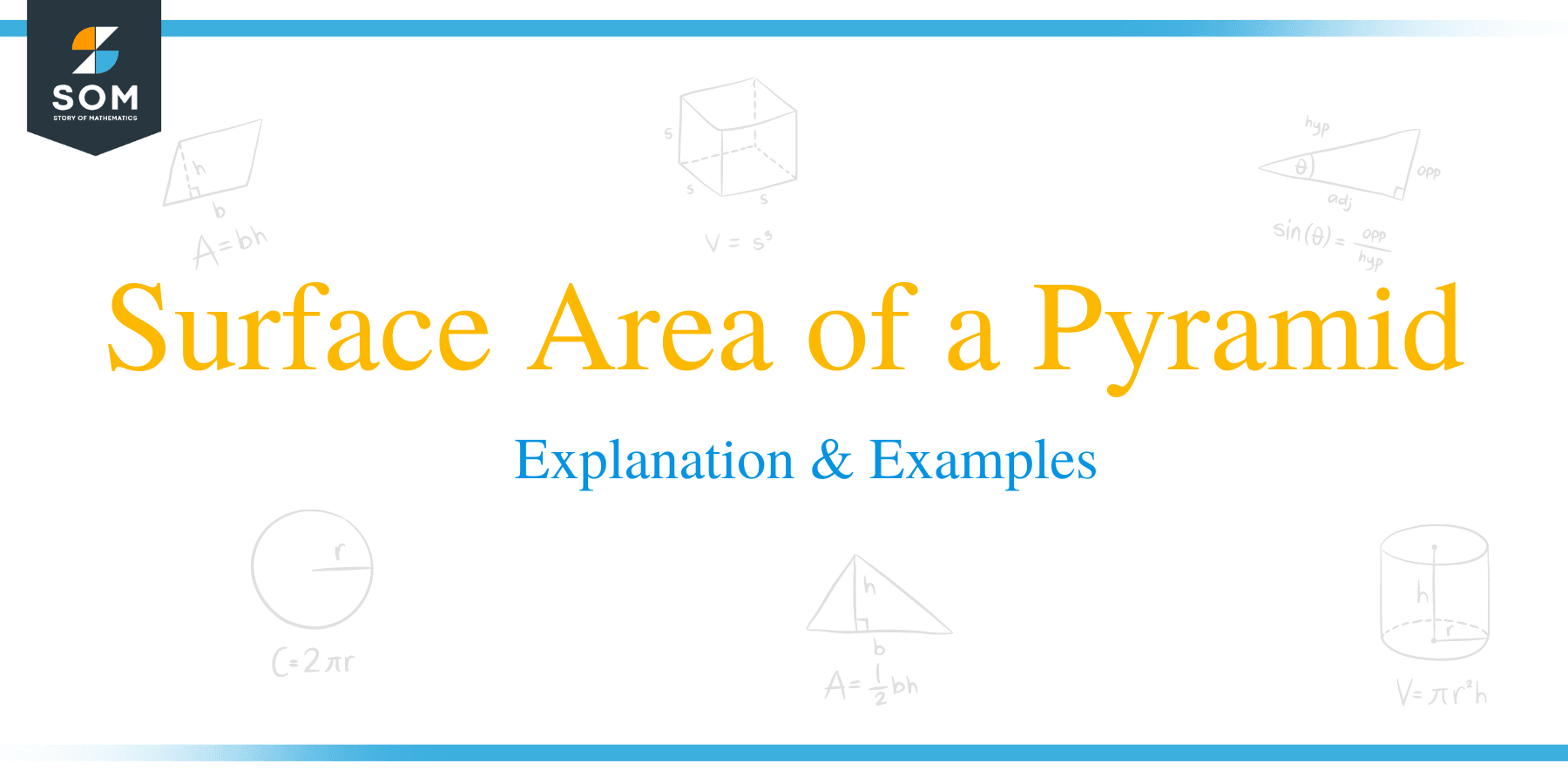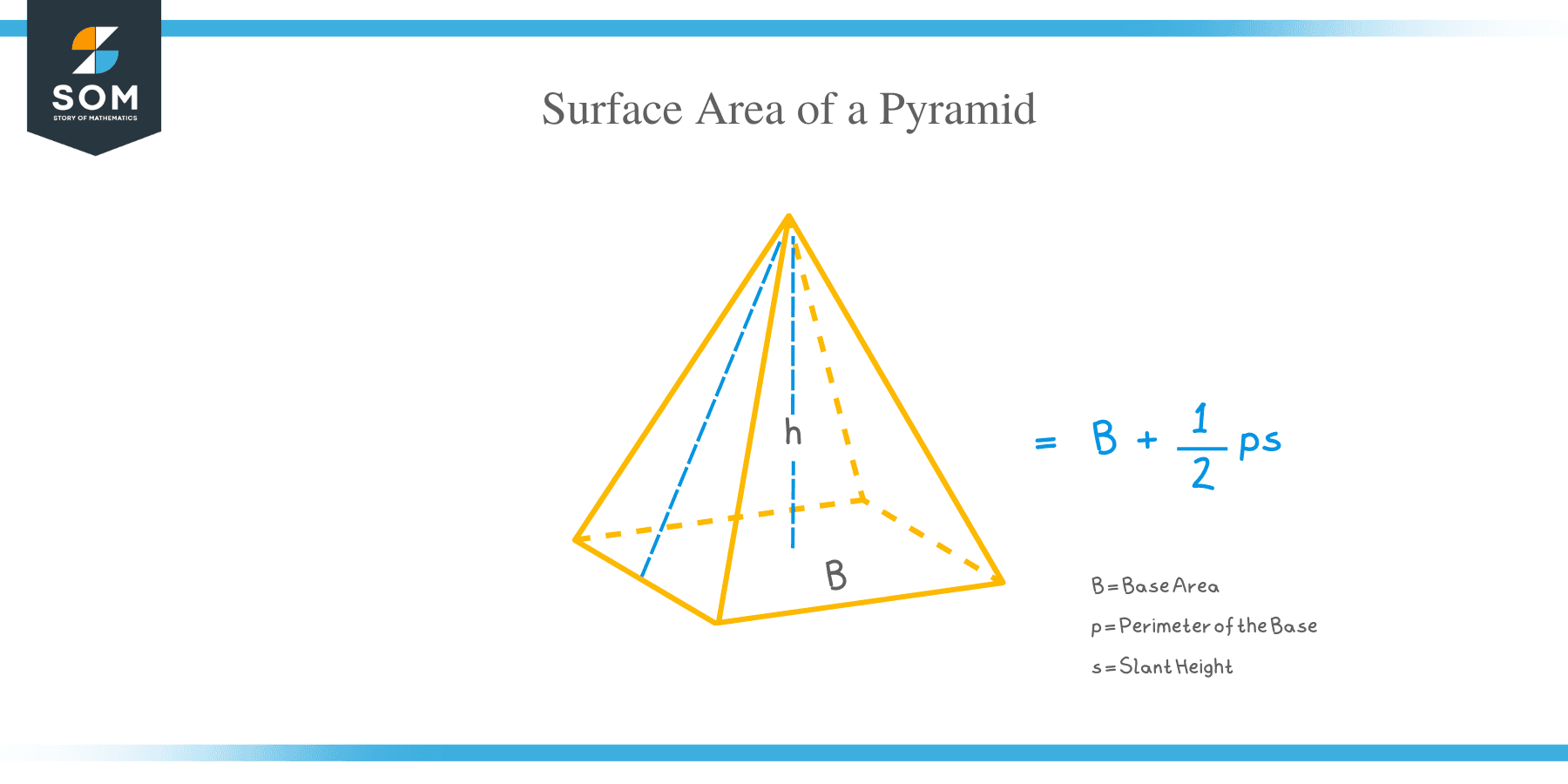- Home
- >
- Surface Area of a Pyramid – Explanation & Examples
JUMP TO TOPIC
Surface Area of a Pyramid – Explanation & Examples
 Before we get started, let’s review what a pyramid is. In geometry, a pyramid is a three-dimensional solid whose base is any polygon, and the lateral faces are triangles.
Before we get started, let’s review what a pyramid is. In geometry, a pyramid is a three-dimensional solid whose base is any polygon, and the lateral faces are triangles.
In a pyramid, the lateral faces (which are triangles) meet at a common point known as a vertex. The name of a pyramid is derived from the name of the polygon forming its base. For example, a square pyramid, a rectangular pyramid, a triangular pyramid, a pentagonal pyramid, etc.
The surface area of a pyramid is the sum of the area of the lateral faces.
This article will discuss how to find the total surface area and lateral surface area of a pyramid.
How to Find the Surface Area of a Pyramid?
To find the surface area of a pyramid, you have to get the area of the base, then add the area of the lateral sides, which is one face times the number of sides.
Surface of a pyramid formula
The general formula for the surface area of any pyramid (regular or irregular) is given as:
Surface area = Base area + Lateral area
Surface area = B + LSA
Where TSA = total surface area
B = base area
LSA = lateral surface area.
For a regular pyramid, the formula is given as:
The total surface area of regular pyramid = B + 1/2 ps
where p = perimeter of the base and s = slant height.
Note: Never confuse the slant height (s) and height (h) of a pyramid. The perpendicular distance from the vertex to the base of a pyramid is known as the height (h), while the diagonal distance from the pyramid’s apex to the edge of the base is known as the slant height (s).
Surface area of a square pyramid
For a square pyramid, the total surface area = b (b + 2s)
Where b = the base length and s = slant height
Surface area of a triangular pyramid
The surface area of a triangular pyramid = ½ b (a + 3s)
Where, a = apothem length of a pyramid
b = base length
s = slant height
Surface area of a pentagonal pyramid
The total surface area of a regular pentagonal pyramid is given by;
Surface area of a pentagonal pyramid = 5⁄2 b (a + s)
Where, a = apothem length of the base
and b = side length of the base, s = slant height of the pyramid
Surface area of the hexagonal pyramid
A hexagonal pyramid is a pyramid with a hexagon as the base.
The total surface area a hexagonal pyramid = 3b (a + s)
Lateral Surface Area of a Pyramid
As stated earlier, the lateral surface area of a pyramid is the area of lateral faces of a pyramid. Since all the lateral faces of a pyramid are triangles, then the pyramid’s lateral surface area is half the product of the perimeter of the pyramid’s base and the slant height.
Lateral surface area (LSA = 1/2 ps)
Where p = perimeter of the base and s = slant height.
Let’s gain an insight into the surface area of a pyramid formula by solving a few example problems.
Example 1
What is the surface area of a square pyramid whose base length is 4 cm and slant height is 5 cm?
Solution
Given:
Base length, b = 4 cm
Slant height, s =5 cm
By the formula,
Total surface area of a square pyramid = b (b + 2s)
TSA = 4(4 + 2 x 5)
= 4(4 + 10)
= 4 x 14
=56 cm2
Example 2
What is the surface area of a square pyramid with a perpendicular height of 8 m and base length of 12 m?
Solution
Given;
Perpendicular height, h = 8 m
Base length, b =12
To get the slant height s, we apply the Pythagorean Theorem.
s = √ [82 + (12/2)2]
s = √ [82 + 62]
s = √ (64 + 36)
s =√100
= 10
Hence, the slant height of the pyramid is 10 m
Now, calculate the surface area of the pyramid.
SA = b (b + 2s)
= 12 (12 + 2 x 10)
= 12(12 + 20)
= 12 x 32
= 384 m2.
Example 3
Calculate the pyramid’s surface area, whose slant height is 10 ft, and its base is an equilateral triangle of side length, 8 ft.
Solution
Given:
Base length = 8 ft
Slant height = 10 ft
Apply the Pythagorean theorem to get the apothem length of the pyramid.
a = √ [82 – (8/2)2]
= √ (64 – 16)
= √48
a = 6.93 ft
Thus, the apothem length of the pyramid is 6.93 ft.
But, the surface area of a triangular pyramid = ½ b (a + 3s)
TSA = ½ x 8(6.93 + 3 x 10)
= 4 (6.93 + 30)
= 4 x 36.93
= 147.72 ft2
Example 4
Find the surface area of a pentagonal pyramid whose apothem length is 8 m, base length 6 m, and slant height is 20 m.
Solution
Given;
Apothem length, a = 8 m
Base length, b = 6 m
Slant height, s = 20 m
Surface area of a pentagonal pyramid = 5⁄2 b (a + s)
TSA = 5/2 x 6(8 + 20)
= 15 x 28
= 420 m2.
Example 5
Calculate the total surface area and lateral surface area of a hexagonal pyramid with the apothem as 20 m, base length as 18 m, and slant height as 35 m.
Solution
Given;
apothem, a = 20 m
Base length, b =18 m
Slant height, s = 35 m
The surface area a hexagonal pyramid = 3b (a + s)
= 3 x 18(20 + 35)
= 54 x 55
= 2,970 m2.
The lateral surface area of a pyramid =1/2 ps
Perimeter, p = 6 x 18
= 108 m
LSA = ½ x 108 x 35
= 1,890 m2
